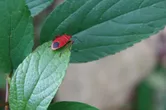Harmful Effects of Dysdercus decussatus
A species of Red cotton bugs
Dysdercus decussatus poses risks to agriculture by sucking fluids from seeds and fruits, diminishing crop quality and yield, particularly in cotton, okra, and hibiscus. They can also spread plant diseases, further impacting crop production and potentially affecting global trade and farmer livelihoods.
What Type of Pest Is Dysdercus decussatus?









AI entomologist in your pocket
Scan QR code to download

